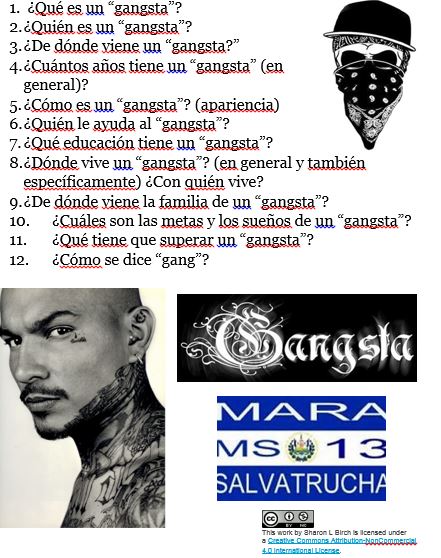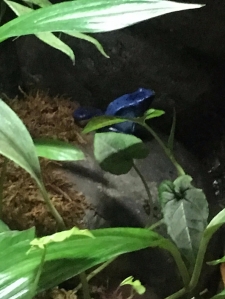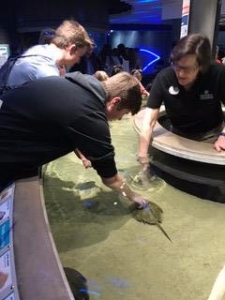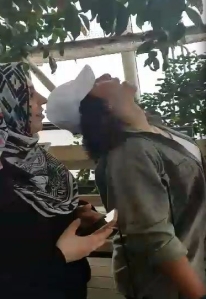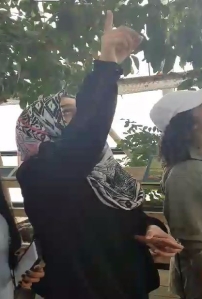I know that some of you follow my Pinterest music board, and some might have my old database for music. But, today is a snow day, so I thought I’d take advantage of it and share some of my newest music interests, spanning Colombia, Mexico, Argentina, Uruguay, Venezuela, Chile and Morocco. So, in no particular order, and just for fun, here are some current songs in rotation, or will be in rotation soon.
 Juanes: La Plata ft. Lalo Ebratt I will admit that although I have been a huge Juanes fan since 2003, I was beginning to despair (after the past 3 years with the exception of Besos en Guerra) that I would find another appropriate song (for high school) that I could share with my students with the impact or “catchiness” of A Dios le Pido, Fotografía, Segovia, Minas Piedras, La Camisa Negra, Nada Valgo sin Tu Amor, Mala Gente, Fuego, La Luz, etc. etc. etc. At age 46, I was beginning to wonder if he would remain relevant. This song, featuring Colombian reggaeton/trap artist Lalo Ebratt, blends Colombian vallenato with a bit of reggaeton and makes me really anticipate the release of his newest album. It is a fun, light hearted, catchy and basically school appropriate song about getting over heartbreak. Filled with cultural images (Colombian police vehicles, spiritual folklore, Colombian flag colors, la plata, el acordeón, etc.), the video rewinds events about spending all his money on his special girl. The very catchy, repetitive chorus goes:Si yo te quiero con el alma (Alma)
Juanes: La Plata ft. Lalo Ebratt I will admit that although I have been a huge Juanes fan since 2003, I was beginning to despair (after the past 3 years with the exception of Besos en Guerra) that I would find another appropriate song (for high school) that I could share with my students with the impact or “catchiness” of A Dios le Pido, Fotografía, Segovia, Minas Piedras, La Camisa Negra, Nada Valgo sin Tu Amor, Mala Gente, Fuego, La Luz, etc. etc. etc. At age 46, I was beginning to wonder if he would remain relevant. This song, featuring Colombian reggaeton/trap artist Lalo Ebratt, blends Colombian vallenato with a bit of reggaeton and makes me really anticipate the release of his newest album. It is a fun, light hearted, catchy and basically school appropriate song about getting over heartbreak. Filled with cultural images (Colombian police vehicles, spiritual folklore, Colombian flag colors, la plata, el acordeón, etc.), the video rewinds events about spending all his money on his special girl. The very catchy, repetitive chorus goes:Si yo te quiero con el alma (Alma)
Si yo te quiero hasta los hueso’
Mi corazón no es sólo tuyo (No es sólo-sólo)
Pero por hoy yo te lo presto (Oye)
Mi corazón no es sólo tuyo (¿Ah?)
Pero por hoy yo te lo presto Los Polinesios and RedOne: Festival I must admit I knew nothing about them, but the group Los Polinesios and the producer/writer/singer RedOne have quite the following on youtube platforms and the Latin music world. Los Polinesios are three siblings from Mexico: Rafa, Karen, Lesslie. According to Lesslie, the message of the song is “Disfruta la vida porque la vida es un festival.” RedOne was born Nadir Khayat in Morocco and has worked with Enrique Iglesias, Lady Gaga, Shakira, Jenifer Lopez, Pitbull……. With it’s English/Spanish chorus, it is one addictive rhythm: Baby here we go
Los Polinesios and RedOne: Festival I must admit I knew nothing about them, but the group Los Polinesios and the producer/writer/singer RedOne have quite the following on youtube platforms and the Latin music world. Los Polinesios are three siblings from Mexico: Rafa, Karen, Lesslie. According to Lesslie, the message of the song is “Disfruta la vida porque la vida es un festival.” RedOne was born Nadir Khayat in Morocco and has worked with Enrique Iglesias, Lady Gaga, Shakira, Jenifer Lopez, Pitbull……. With it’s English/Spanish chorus, it is one addictive rhythm: Baby here we go
Esta noche no va a terminar
flylight oh oh oh ueh ohh
que la vida es un festival
- Nacho ft. Los Mendoza: Happy Happy Fans of the old Venezuelan duo Chino and Nacho will be happy to see Nacho ( Miguel Ignacio Mendoza Donatti) with three of his sons (Diego, Miguel and Santi known as Los Mendoza) promoting this upbeat song. Another mixture of English/Spanish, what’s not to like about lyrics referring to the Venezuelan ice cream (grape flavored, I think) bati bati that comes with chicle at the bottom? Happy happy
Happy happy happy
No sé qué me hiciste pero te amo de gratis
Yo soy el chicle de tu bati bati
And all I want is to make you happy

4. LIT Killah ft. Agus Padilla: Tan Bien When Laura Sexton shared her post about top songs for 2019, she included one by Uruguayan Agus Padilla called Ni Tu Amiga Ni Tu Amante. I was not familiar with her music and looked her up and discovered this collaboration between her and Argentinian LIT Killah (both of them are 18 years old!) My kids did not respond well to her individual song, but they LOVED Tan Bien, and asked for it everyday last week. A female empowerment song, she liked him when she was young and awkward but the feeling was not reciprocated. Now grown up, he likes her but she’s not interested. With a vintage Latin sound of trumpets and piano fused with rap style lyrics, this is one appealing song! Hey, ¿Qué paso?
Ahora tú eres la que me dice que no
Y en el pasado fui quien te rechazó
Pero ahora la cosa cambió y esa mujer se reveló
Me dio la espalda y me enteré que soy yo
El que se dio cuenta de lo que perdió

5. Américo feat. Silvestre Dangond: Mi Deseo This collaboration between Chilean Américo and Colombian Silvestre Dangond features a fusion of musical styles between cumbia, vallenato and urban in a love song in which they are saying goodbye to the love of their life, wishing her happiness even with another man…..but we discover in the beginning that it is his daughter he is sending off to the man she is marrying!!! What a sweet video (and what uses of subjunctive)!
Tengo que entender, que tú te irás
que va a llegar el día y me vas a dejar
por que tu no eres mía y tengo que aceptar
la realidad
Ay que seas feliz feliz feliz, aunque estés con otro
que seas feliz feliz y yo con el corazón roto
que seas feliz feliz feliz, pero muy feliz feliz feliz
ese es mi deseo, es lo que más deseo
I’m stopping with five, but there are a lot more on my board. What are you listening to?


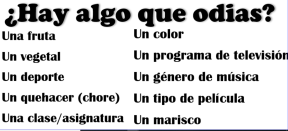
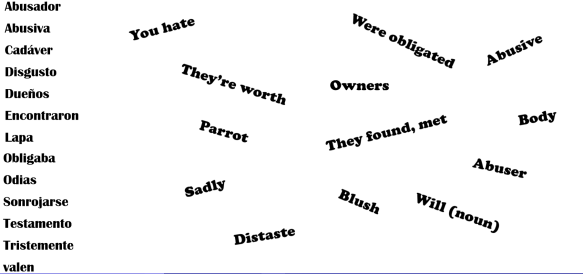
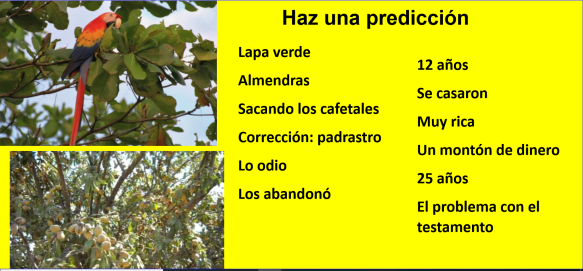
 It’s the end of the year. We’re still in school! The days seem endless and the students are not very motivated. What to do? Fall back on the one thing that has connected us from the very beginning: music! When I start thinking about how much music my Spanish IV students (who have had me for 2 years) have been exposed to, it’s a bit overwhelming. They LOVE music. There is no other way to put it. Even the most hardened, most resistant, most determined to not like anything student has connected with some song. I really don’t know how many of my students maintain Spanish playlists that they listen to on their own time, but it is a lot! They love being able to rush to me on Mondays and ask me if I have heard the latest from…. Sometimes they discover new songs before I do! So, I decided that I would try a version of a game that I loved a long time ago: Name That Tune! Of course, I have modified it for my purposes and it probably doesn’t resemble the original very much. Additionally, if I had more time (and more motivation), I could have made it a lot better and added categories for specific items (sports, individual artists, individual countries, individual genres, etc.). However, I didn’t (and don’t), so I’m going to give this format a try. If you’d like to try it, I’d love to hear from you. If you have the time/initiative and you add to it, please let me know.
It’s the end of the year. We’re still in school! The days seem endless and the students are not very motivated. What to do? Fall back on the one thing that has connected us from the very beginning: music! When I start thinking about how much music my Spanish IV students (who have had me for 2 years) have been exposed to, it’s a bit overwhelming. They LOVE music. There is no other way to put it. Even the most hardened, most resistant, most determined to not like anything student has connected with some song. I really don’t know how many of my students maintain Spanish playlists that they listen to on their own time, but it is a lot! They love being able to rush to me on Mondays and ask me if I have heard the latest from…. Sometimes they discover new songs before I do! So, I decided that I would try a version of a game that I loved a long time ago: Name That Tune! Of course, I have modified it for my purposes and it probably doesn’t resemble the original very much. Additionally, if I had more time (and more motivation), I could have made it a lot better and added categories for specific items (sports, individual artists, individual countries, individual genres, etc.). However, I didn’t (and don’t), so I’m going to give this format a try. If you’d like to try it, I’d love to hear from you. If you have the time/initiative and you add to it, please let me know.


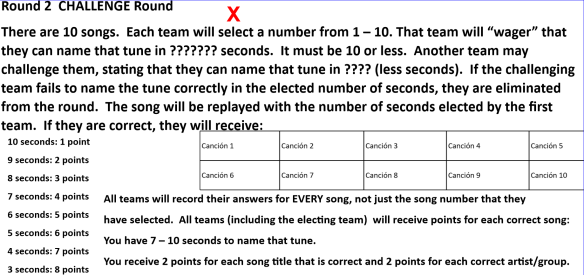







 I followed it with this slide:
I followed it with this slide:  We then did some brainstorming as a class, using this slide:
We then did some brainstorming as a class, using this slide:  The next day I put them in groups of three and gave each group a large baggie that contained the three time periods (antes de, en el medio de and después de) and many events for each category. Their task was to sort the events into the time period they thought they belonged. I will not lie, this was difficult for them, and after about 7 minutes we regrouped and talked about what we had for before or after. Several days later, we tried it again with more success. I strongly feel that it was beneficial, but that, of course, is just my opinion.
The next day I put them in groups of three and gave each group a large baggie that contained the three time periods (antes de, en el medio de and después de) and many events for each category. Their task was to sort the events into the time period they thought they belonged. I will not lie, this was difficult for them, and after about 7 minutes we regrouped and talked about what we had for before or after. Several days later, we tried it again with more success. I strongly feel that it was beneficial, but that, of course, is just my opinion. 
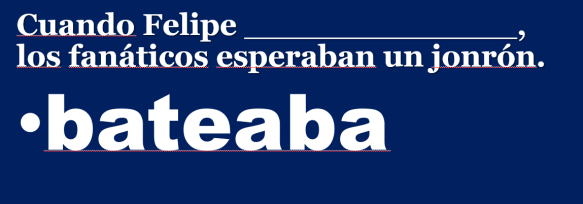
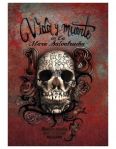 This makes my 4th year with the superb
This makes my 4th year with the superb 




 I decided that one of the first activities that we would do would be to work with the song,
I decided that one of the first activities that we would do would be to work with the song,  Nine years ago, in 2008, I attended a world language conference in Maryland. It was in a session there that an idea was planted in my head. I wish that I could remember who the speaker was, but I don’t. She shared with us the idea of a type of talent show that featured talent in many languages. The next year, in 2009, the first Cabaret at James M. Bennett High School took place. Indeed, it was a celebration of talent: singing, dancing, skits, poetry recitation and instrumental selections that came from a variety of languages and cultures. Since then, we have held a Cabaret about every two years. I feel very strongly that one of my major responsibilities as a world language teacher is to open a window on the world for my students of rural Delmarva (rural, but with a quite high immigrant population) and to build bridges leading to acceptance and understanding of other cultures. Last night, we held a Cabaret that achieved that, and I will always remember it. It was so very special that I will cherish the warmth, the love and the good feelings for a very long time.
Nine years ago, in 2008, I attended a world language conference in Maryland. It was in a session there that an idea was planted in my head. I wish that I could remember who the speaker was, but I don’t. She shared with us the idea of a type of talent show that featured talent in many languages. The next year, in 2009, the first Cabaret at James M. Bennett High School took place. Indeed, it was a celebration of talent: singing, dancing, skits, poetry recitation and instrumental selections that came from a variety of languages and cultures. Since then, we have held a Cabaret about every two years. I feel very strongly that one of my major responsibilities as a world language teacher is to open a window on the world for my students of rural Delmarva (rural, but with a quite high immigrant population) and to build bridges leading to acceptance and understanding of other cultures. Last night, we held a Cabaret that achieved that, and I will always remember it. It was so very special that I will cherish the warmth, the love and the good feelings for a very long time.




















